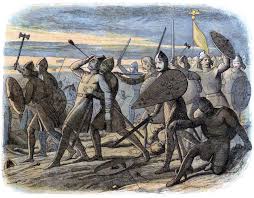
monarchs in England… You know… throughout history. The conquerors and the ones that
inherited all of their wealth and glory. I guess I plan to do both! –Siggie
Link to the Youtube video and the rest of the series!
Fourth Episode of Siggie presenting her take on the history of the monarchs of England in the context of her favorite topic….herself. Here she discusses the last of the Wessex and Danish Kings up through the Norman Invasion of 1066. (This ends part 1 of Siggie the Conqueror, which covers the period of Anglo-Saxon kings from 927-1066 A.D. Part 2, upcoming, will cover the Norman and Plantagenet monarchs from 1066-1399 A.D.)

One thing I’m noticing is that a lot of these kings
died in their late teens or their 20s or their 30s or their 40s and at most
their early to mid-50s. I think that part of the crazed
ruthlessness came from knowing that they had to get it all in while they could
because they knew that they wouldn’t be around for too long. Also it didn’t
matter if you were brothers, if you were related. These guys beat the crap out of
each other to make it to the throne with no conscience about it. Kind of the way I’d
basically beat the crap out of Ulf if I had a chance of going to the throne, but
that’s a different story for a different day. So, there are a couple of House of
Denmark kings before back to the House of Wessex. The House of Denmark kings
included King Harald the First, and also King
Harthacnut. Harthacnut. That’s a mouthful.
King Harald the First reigned from 1035 to 1040. He really wasn’t the people’s
choice. He inherited the throne when his brother and the preferred hair, Harthacnut,
was away in Denmark. He was rejected by the Archbishop of
Canterbury, and he struggled for absolute power. He
died just as his brother was planning to invade England to reclaim his right to
the throne.

So King Harthacnut, this nice and stable fellow,
exhumed and beheaded his dead brother, Harald,
for HIS harsh treatment of another stepbrother who Harald, equally nice and
stable, had blinded and exiled. King Harthacnut ruled pretty freaking poorly
I must say. He increased taxes at a time when there were poor harvests. This led
to civil unrest. He died after drinking to the health of a bride. Isn’t
that ironic? He drank to the health of a bride and then he died. Yeah. I made
another rhyme. Back to the House of Wessex. Another
saint. This was saint Edward the Confessor, who reigned from 1042 to 1066.
Edward’s half-brother was King Harthacnut. Edward became king when Harthacnut
died. He struggled for power against Godwin the
Earl of Wessex. As to what he
confessed, I have absolutely no idea. We have to look it up. We have to do a
Google search. We go now from the House of Wessex to
the House of Godwin to King Harold II. King Harold II was the last Anglo-Saxon
king of England. He had some luck at the battle of
Stamford Bridge, where he defeated his brother. But things really sucked just
days after that when he was killed at the Battle of Hastings where William of
Normandy invaded. King Harold II’s reignwas from January 1066 to October 1066.
Another really… like a laughably short reign. All right. Back to the
House of Wessex with King Edgar II, who reigned a whopping two months from
October 1066 to December 1066. King Edgar II was the grandson of the deposed
King Edmund II. King Edmund II had the… he was the one with the short and the
violent reign and he was succeeded by King Cnut of the House of Denmark.
Anyway, Edgar was one of four kings to rule in 1066. 1066 was one wild party of
a year, I guess. He was pronounced king after the death of King Harold II, but
everything fell apart when William the First or William the Conqueror arrived
in London. And this is when it all changed.

(Stay tuned for Episode 5: “The First Norman Kings”)
